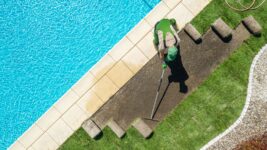
What to Consider Before Landscaping Around Your Pool
I. Introduction
A well-thought-out pool landscaping plan can transform your backyard into a true oasis. Whether you’re working with a sleek inground pool or a compact above-ground setup, the right landscaping approach enhances the beauty, functionality, and enjoyment of your outdoor space. More than just a visual upgrade, landscaping around your pool also plays a crucial role in creating a safe and user-friendly environment for you and your guests.
Incorporating smart pool landscape design isn’t just about choosing pretty plants or paving stones. It’s also about ensuring safety, managing drainage, selecting durable materials, and enhancing the overall flow of your backyard. Many homeowners turn to professional pool landscaping services to help avoid common pitfalls and create a cohesive, long-lasting design. These experts can help you navigate critical decisions, such as plant placement, material selection, and drainage solutions, to ensure everything works in harmony.
Common mistakes, like planting messy trees too close to the water, ignoring proper drainage, or overlooking long-term maintenance, can result in costly repairs or constant upkeep. That’s why working with experienced pool landscaping services can make a huge difference in both function and aesthetics. By avoiding these missteps and starting with a thoughtful strategy, your landscaping around pool areas can be as practical and safe as they are visually appealing.
II. Understanding Your Pool Type and Surroundings
Before diving into plant selections and deck materials, it’s essential to understand what type of pool you’re working with. Landscaping around inground pools allows for more flexibility in terms of hardscaping and plant installations. Since these pools are typically level with the ground, you can create seamless transitions from patio to pool using flush surfaces, built-in lighting, and surrounding garden beds. You’ll also need to consider how rainwater runoff and irrigation will interact with your landscaping design, as improper planning could lead to soil erosion or slippery surfaces.
On the other hand, landscaping around above-ground pools presents a unique set of challenges. Because these pools often sit on top of the ground, elevation differences must be addressed creatively. Decks and raised platforms can help integrate the pool into your yard more organically. Tiered planting beds, lattice screens, and tall grasses can camouflage the pool walls and improve the aesthetic. However, any pool landscape design around above-ground pools must account for structural integrity and avoid moisture buildup that can damage the base of the pool over time.
In both scenarios, don’t forget to assess the overall layout and size of your backyard. A compact space may require minimalistic landscaping, while larger yards offer more room for sprawling designs and water features. Think about how the sun moves across your yard, any existing structures, and whether your landscaping choices will complement or clash with what’s already there. Your pool landscape design should harmonize with its surroundings, not fight against them.
III. Choosing the Right Design and Materials
One of the most overlooked aspects of pool deck landscaping is choosing materials that can withstand the elements while remaining safe underfoot. Your deck isn’t just a place to lounge—it’s a high-traffic zone that’s often exposed to water, sunlight, and pool chemicals. That’s why it’s important to select materials that are not only durable but also practical. Concrete, travertine, and composite decking are all popular choices for poolside landscaping because they resist wear and tear while offering a clean, polished look.
Another vital consideration in pool landscape design ideas is heat resistance. Some materials—like dark stones or certain types of tiles—can become scorching under the sun, making it uncomfortable or even unsafe to walk barefoot. Choosing light-colored or specially treated surfaces can help reduce heat retention. Likewise, slip resistance is critical. Pool areas are almost always wet, and surfaces that become slick can be dangerous. Textured pavers, brushed concrete, and rubberized coatings are great pool deck landscaping options that prioritize safety without sacrificing style.
Additionally, think about how your materials will age over time. Some decks may fade or crack due to weather conditions, while others may require frequent sealing or treatment. Your goal is to find the right balance between aesthetics, safety, and maintenance so that your pool landscape design remains stunning for years to come.
IV. Selecting Plants and Features
When it comes to choosing plants for your pool landscaping, low-maintenance is the name of the game. Opt for greenery that thrives in your climate and doesn’t drop excessive leaves or flowers. Drought-tolerant plants, like agave, lavender, or ornamental grasses, can handle the heat and require little upkeep. These choices reduce the time you’ll spend fishing debris out of your pool and help maintain water quality. Succulents and groundcovers like creeping thyme or blue star creeper also make excellent additions to poolside landscaping, offering lush visuals without constant trimming.
It’s wise to steer clear of debris-heavy plants such as jacarandas, pines, or bougainvillea near your landscaping around pool areas. While beautiful, these species are notorious for shedding and can clog your filters, stain surfaces, or create safety hazards. Instead, consider using container plants, palm varieties, or hedges like boxwood that provide structure and greenery without the mess. By choosing the right pool landscaping ideas, you can create a serene environment that doesn’t sacrifice function.
Don’t forget the power of lighting and decorative features. Subtle, low-voltage LED lighting around pathways and pool edges improves safety and extends the usability of your backyard into the evening. Adding elements like water features, statues, or artistic rock arrangements can elevate your pool landscape design from simple to luxurious. These touches also offer focal points and can help tie your landscaping around an inground pool or landscaping around an above-ground pool into the rest of your yard’s theme.
V. Conclusion
Pool landscaping is more than a finishing touch—it’s a fundamental part of your outdoor living experience. By understanding the unique requirements of your pool type, whether it’s inground or above ground, and making informed decisions about materials, plant selections, and layout, you set the stage for years of relaxation, beauty, and safety. Smart landscaping around pool areas doesn’t just increase your property’s value—it enhances your daily enjoyment of the space.
From the decking under your feet to the greenery surrounding the water, each choice you make in your pool landscape design matters. Take your time to plan thoroughly, consider long-term maintenance, and prioritize both form and function. Whether you’re leaning toward minimalist pool landscaping ideas or envisioning a lush, resort-style haven, the right design can make all the difference. With the proper approach, your poolside landscaping will feel less like a weekend project and more like a permanent upgrade to your lifestyle.




